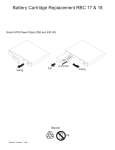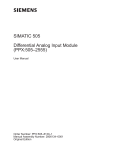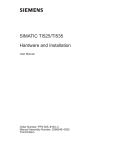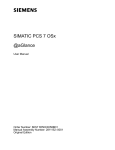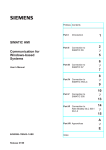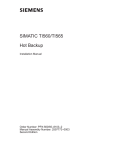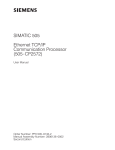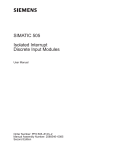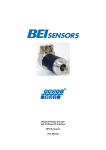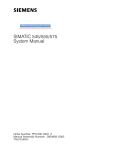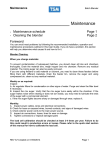Download SIMATIC 505/500 PROFIBUS DP RBC
Transcript
) %$ "' "' %%! ( '!$ #" &#" ! DANGER DANGER indicates an imminently hazardous situation that, if not avoided, will result in death or serious injury. DANGER is limited to the most extreme situations. ! WARNING WARNING indicates a potentially hazardous situation that, if not avoided, could result in death or serious injury, and/or property damage. ! CAUTION CAUTION indicates a potentially hazardous situation that, if not avoided, could result in minor or moderate injury, and/or damage to property. CAUTION is also used for property-damage-only accidents. Copyright 1999 by Siemens Energy & Automation, Inc. All Rights Reserved — Printed in USA Reproduction, transmission, or use of this document or contents is not permitted without express consent of Siemens Energy & Automation, Inc. All rights, including rights created by patent grant or registration of a utility model or design, are reserved. Since Siemens Energy & Automation, Inc., does not possess full access to data concerning all of the uses and applications of customer’s products, we do not assume responsibility either for customer product design or for any infringements of patents or rights of others which may result from our assistance. MANUAL PUBLICATION HISTORY SIMATIC 505/500 PROFIBUS-DP RBC User Manual Order Manual Number: Not applicable; manual ships with RBC. Refer to this history in all correspondence and/or discussion about this manual. Event Date Description Original Issue Second Edition 03/96 06/99 Original Issue (2806091–0001) Second Edition (2806091–0002) LIST OF EFFECTIVE PAGES Pages Cover/Copyright History/Effective Pages 1 — 28 Registration Description Second Edition Second Edition Second Edition Second Edition Pages Description Contents 1 2 3 4 5 6 7 8 Overview . . . . . . . . . . . . . . . . . . . . . . . . . . . . . . . . . . . . . . . . . . . . . . . . . . . . . . . . . . . . . . . . . . . . . . . 2 Features and Functions . . . . . . . . . . . . . . . . . . . . . . . . . . . . . . . . . . . . . . . . . . . . . . . . . . . . . . . . . RBC Specifications . . . . . . . . . . . . . . . . . . . . . . . . . . . . . . . . . . . . . . . . . . . . . . . . . . . . . . . . . . . . . . 2 2 Setup and Installation . . . . . . . . . . . . . . . . . . . . . . . . . . . . . . . . . . . . . . . . . . . . . . . . . . . . . . . . . . . 4 RBC Placement in Base . . . . . . . . . . . . . . . . . . . . . . . . . . . . . . . . . . . . . . . . . . . . . . . . . . . . . . . . . Installing and Removing the RBC . . . . . . . . . . . . . . . . . . . . . . . . . . . . . . . . . . . . . . . . . . . . . . . . 4 5 RBC Ports . . . . . . . . . . . . . . . . . . . . . . . . . . . . . . . . . . . . . . . . . . . . . . . . . . . . . . . . . . . . . . . . . . . . . . . 6 RS-232 Port . . . . . . . . . . . . . . . . . . . . . . . . . . . . . . . . . . . . . . . . . . . . . . . . . . . . . . . . . . . . . . . . . . . . . PROFIBUS-DP Port . . . . . . . . . . . . . . . . . . . . . . . . . . . . . . . . . . . . . . . . . . . . . . . . . . . . . . . . . . . . . . . 6 7 Output State Selection on the RBC . . . . . . . . . . . . . . . . . . . . . . . . . . . . . . . . . . . . . . . . . . . . . . . 8 Selecting Output State (Off/Freeze) on the 505 RBC . . . . . . . . . . . . . . . . . . . . . . . . . . . . . . Selecting Output State (Off/Freeze) on the 500 RBC . . . . . . . . . . . . . . . . . . . . . . . . . . . . . . Determining Discrete Output State . . . . . . . . . . . . . . . . . . . . . . . . . . . . . . . . . . . . . . . . . . . . . . Determining Analog Output State . . . . . . . . . . . . . . . . . . . . . . . . . . . . . . . . . . . . . . . . . . . . . . . 8 9 10 10 Dipswitch Options: Baud Rate, Station Address, Status Display Mode . . . . . . . . . . . . . . . 11 Dipswitch Options . . . . . . . . . . . . . . . . . . . . . . . . . . . . . . . . . . . . . . . . . . . . . . . . . . . . . . . . . . . . . . Baud Rate for the RS-232 Port . . . . . . . . . . . . . . . . . . . . . . . . . . . . . . . . . . . . . . . . . . . . . . . . . . . . Assigning the RBC Station Address . . . . . . . . . . . . . . . . . . . . . . . . . . . . . . . . . . . . . . . . . . . . . . . Reset Pushbutton . . . . . . . . . . . . . . . . . . . . . . . . . . . . . . . . . . . . . . . . . . . . . . . . . . . . . . . . . . . . . . . Resetting the RBC . . . . . . . . . . . . . . . . . . . . . . . . . . . . . . . . . . . . . . . . . . . . . . . . . . . . . . . . . . . . . . . Status Display Mode . . . . . . . . . . . . . . . . . . . . . . . . . . . . . . . . . . . . . . . . . . . . . . . . . . . . . . . . . . . . 11 13 13 16 16 18 Parameters Set by Software . . . . . . . . . . . . . . . . . . . . . . . . . . . . . . . . . . . . . . . . . . . . . . . . . . . . . 20 Setting User Parameters for the PROFIBUS-DP RBC . . . . . . . . . . . . . . . . . . . . . . . . . . . . . . . . . Discrete I/O Interval . . . . . . . . . . . . . . . . . . . . . . . . . . . . . . . . . . . . . . . . . . . . . . . . . . . . . . . . . . . . . Word I/O Update Factor . . . . . . . . . . . . . . . . . . . . . . . . . . . . . . . . . . . . . . . . . . . . . . . . . . . . . . . . 50X Ignore Mismatch Mode . . . . . . . . . . . . . . . . . . . . . . . . . . . . . . . . . . . . . . . . . . . . . . . . . . . . . 50X RS-232 Comm Port . . . . . . . . . . . . . . . . . . . . . . . . . . . . . . . . . . . . . . . . . . . . . . . . . . . . . . . . . . 20 20 20 20 20 Diagnostic Data Reported by the RBC . . . . . . . . . . . . . . . . . . . . . . . . . . . . . . . . . . . . . . . . . . . . 21 PROFIBUS-DP Diagnostic Bytes . . . . . . . . . . . . . . . . . . . . . . . . . . . . . . . . . . . . . . . . . . . . . . . . . . . 21 Upgrading the Operating System . . . . . . . . . . . . . . . . . . . . . . . . . . . . . . . . . . . . . . . . . . . . . . . . 26 Overview . . . . . . . . . . . . . . . . . . . . . . . . . . . . . . . . . . . . . . . . . . . . . . . . . . . . . . . . . . . . . . . . . . . . . . . Download Instructions . . . . . . . . . . . . . . . . . . . . . . . . . . . . . . . . . . . . . . . . . . . . . . . . . . . . . . . . . . Technical Assistance . . . . . . . . . . . . . . . . . . . . . . . . . . . . . . . . . . . . . . . . . . . . . . . . . . . . . . . . . . . . 26 27 28 SIMATIC 505/500 PROFIBUS-DP RBC User Manual 1 1 Overview Features and Functions The SIMATICr 505 PROFIBUS-DP Remote Base Controller (RBC), PPX:505–6870, allows a Series 505t I/O base to function as a slave node on a DP I/O channel that complies with the PROFIBUS standard (DIN 19245, Part 3). The SIMATIC 500 PROFIBUS-DP Remote Base Controller (RBC), PPX:500–6870, allows a Series 500t I/O base to function as a slave node on a DP I/O channel that complies with the PROFIBUS standard. The 505 and 500 PROFIBUS-DP RBCs offer the following features: • The RBC is compatible with Siemens S5t and S7t, as well as Series 505, masters. • The 505 RBC can be used in all currently-available Series 505 bases (4-, 8-, 11-, and 16-slot models). • The 500 RBC can be used in all Series 500 bases (6-, 12-, and 14-slot models, or original 8- and 16-slot models with PPX:500–5840 adapter). • The RBC supports communication speeds from 9.6 Kbaud (maximum cable distance per segment: 1200 m) up to 12 Mbaud (maximum cable distance per segment: 100 m). • The LED display shows error codes or current station address. • A serial port is available for remote programming of the CPU when the RBC is used on a Series 505/500 system. • The RBC has a field-upgradeable operating system that is stored in flash memory. • The base where the RBC resides can contain only modules that look like discrete or analog I/O; Special Function modules like Peerlink or NIMs are not supported. • CPU commands received from the serial port are restricted to those that cannot alter the PROFIBUS-DP I/O configuration. • A “GSD” file is provided with the RBC to allow configuration by the COM PROFIBUS configuration utility. Figure 1 illustrates how the 505 and 500 PROFIBUS-DP RBCs fit into the I/O architecture of a Series 505 system. RBC Specifications 2 The physical and environmental specifications for the 505 PROFIBUS-DP RBC are listed in the SIMATIC 545/555/575 System Manual. SIMATIC 505/500 PROFIBUS-DP RBC User Manual 545/555/575 C P U PROFIBUS-DP I/O Channel (12 Mbaud) Series 505 Remote I/O Channel (1 Mbaud) Series 505 Base with RBC (PPX:505–6851–A/B RBC) R B C R B C (PPX:500–5114–A RBC) (PPX:505–6870 RBC) ET200U R B C Series 500 Base with RBC Series 505 Base with 505 PROFIBUS-DP RBC 95U/PROFIBUS-DP Series 500 Base with 500 PROFIBUS-DP RBC R B C (PPX:500–6870 RBC) ET200B Block I/O ET200C AS-Interface Master S7 I/O AS-Interface Bus Limit SW P/B Solenoid PE Cell Siemens AC/DC Motors and Drives Allen-Bradley Festo Metlore-Toledo Data Logic ABB AEG-Modicon Bosch Turk etc. Third Party Products Notes: The Series 505 remote I/O channel supports up to 15 Series 505/Series 500 remote bases. The PROFIBUS-DP I/O channel supports up to 112 SIMATIC and third-party DP I/O slaves. A 575–2104 CPU can support either the 505 I/O channel or the PROFIBUS-DP channel, but not both simultaneously. The 545–1103/–1105 CPUs support only the PROFIBUS-DP channel, up to 32 SIMATIC and third-party DP I/O slaves, with the optional PROFIBUS-DP I/O annex card. Figure 1 I/O Architecture for Series 505 System SIMATIC 505/500 PROFIBUS-DP RBC User Manual 3 2 Setup and Installation RBC Placement in Base The 505 PROFIBUS-DP RBC resides in a Series 505 base. Install it in the second slot from the left, adjacent to the power supply module. See Figure 2. P/S 505 I I I I I I I I RBC / / / / / / / / O O O O OO O O Figure 2 Location of RBC in a Series 505 Base The 500 PROFIBUS-DP RBC resides in a Series 500 base. Install it in the rightmost slot, adjacent to the power supply module. See Figure 3. Series 500 Remote Base Controller Power Supply Figure 3 Location of RBC in a Series 500 Base 4 SIMATIC 505/500 PROFIBUS-DP RBC User Manual Installing and Removing the RBC Use the following steps to install the 505–6870 RBC in a Series 505 base or to install the 500–6870 RBC in a Series 500 base. ! WARNING Installing or removing an RBC from a powered-up base disrupts your process and can damage the RBC. Disruption of your process can cause death or serious injury to personnel, and/or damage to equipment. Ensure that all power is disabled before installing or removing the RBC. ! CAUTION The RBC is sensitive to, and can be damaged by, electrostatic discharge. Ensure that personnel make contact with a static-dissipative pad and/or wear a grounded wrist strap when handling the RBC. 1. Verify that all jumper settings on the 505 RBC or the Off/Freeze toggle switch on the 500 RBC are correct. See Section 4. It is advisable to set the dipswitch options before installing the module. See Section 5. 2. Disconnect power to the base. 3. Position the RBC so that the bezel is facing you. 4. Grasp the top and bottom of the RBC. 5. Carefully push the RBC into the slot until it mates with the backplane connector. 6. Tighten the top and bottom bezel screws. ! CAUTION Series 505 RBCs are not designed to be installed in VME bases. Doing so results in damage to equipment. Never attempt to install any Series 505 RBC in a VME base. To remove the RBC, complete the following steps. 1. If attached, remove cables from the RBC. 2. Disconnect power to the base. 3. Loosen the top and bottom bezel screws. 4. Carefully pull the RBC from the base. SIMATIC 505/500 PROFIBUS-DP RBC User Manual 5 3 RBC Ports The 505 and 500 PROFIBUS-DP RBCs have two communication ports, an RS-232 port and a PROFIBUS-DP I/O channel port. RS-232 Port When used with a Series 505 CPU, the RS-232 port is an interface to programming devices that use software like TISOFT or other configuration tools. To connect your RBC to a programming device/modem, use a standard 9-pin RS-232 serial cable that conforms at a minimum to the pinouts shown in Figure 4. A standard cable that conforms to the minimum requirements is available through Siemens; specify part number 2601094–8001. Programming Device/Modem Pinouts RBC RS-232/423 Pinouts 9-Pin, Female D-Connector 5 Signal Ground (5) 5 Signal Ground 9 9 3 Transmit Data (3) Receive Data (2) 2 1 6 3 Transmit Data 2 Receive Data 1 6 Shield Figure 4 RS-232 Serial Port, Minimum Cable Pinouts Figure 5 shows the 25-pin cable connector pinouts required for the 25-pin female communications port on the 500 RBC. Programming Device/Modem Pinouts RBC RS-232/423 Pinouts 1 1 6 Receive Data 2 Transmit Data 3 14 2 7 15 Transmit Data 3 8 16 Receive Data 4 17 5 18 6 19 7 20 8 4 Signal Ground 5 9-Pin, Female D-Connector 9 Shield Note: You can use the standard Siemens programming cable (#2601094–8001) with a 9-to-25-pin male adapter. 21 9 22 10 23 11 24 12 25 13 Signal Ground 25-Pin, Male D-Connector Figure 5 500 RBC RS-232 Serial Communications Cable Pinouts 6 SIMATIC 505/500 PROFIBUS-DP RBC User Manual PROFIBUS-DP Port The PROFIBUS-DP port is used to connect the RBC to the PROFIBUS-DP I/O channel. The SIMATIC 545/555/575 System Manual describes how to connect a 12 Mbaud RS-485 cable to the PROFIBUS-DP port. Figure 6 shows the pinout for the PROFIBUS-DP port for the PROFIBUS-DP RBC. NOTE: Pins 2 and 7 are “No Connect” for the RBC. For some PROFIBUS products, these pins are used to provide 24 VDC for powering a programming or configuration tool. Such tools are not powered by the RBC; however, it is acceptable for an externally-powered PROFIBUS programming or configuration tool to drive pins 2 and 7 to 24 VDC. Female 9-Pin D-Connector Pin (D-shell) CHASSIS GND TX/RX– (8) 5 4 3 2 1 9 8 7 6 BIAS SUPPLY GND (5) TX/RX+ (3) Signal 1 CHASSIS GND 2 NO CONNECT *3 TX/RX+ 4 RTS 5 BIAS SUPPLY GND 6 BIAS SUPPLY +5V 7 NO CONNECT *8 9 TX/RX– BIAS SUPPLY GND * For Pin 3: Terminal B on Siemens connector. * For Pin 8: Terminal A on Siemens connector. Figure 6 PROFIBUS-DP I/O Port Pinouts ! CAUTION Pin 5 (BIAS SUPPLY +5V) and Pin 6 (BIAS SUPPLY GND) on the PROFIBUS-DP connector are designed to support the PROFIBUS-DP I/O channel only. These pins have a limited output power capability of approximately 0.45 W, which greatly exceeds the typical PROFIBUS-DP load; however, overloading these pins may cause internal component damage. If the pins are overloaded, the PROFIBUS-DP port can be rendered non-functional, requiring the unit to be returned to the factory for repair. Do not overload the pins on the PROFIBUS-DP connector. SIMATIC 505/500 PROFIBUS-DP RBC User Manual 7 4 Output State Selection on the RBC Selecting Output State (Off/Freeze) on the 505 RBC When I/O channel communication to a Series 505 base is lost, the state of the outputs is determined by the selection made on the 505 RBC jumper E1 (Off/Freeze). Figure 7 shows the location of the jumpers on the 505 RBC. NOTE: You must make an E1 jumper selection on the 505 RBC. The RBC Status Display reports an error if no jumper selection is made. The jumpers on the 505 RBC headers E2 and E3 are for factory use only. Header E4 is shipped without a jumper. Do not alter the default settings unless instructed to do so by a Siemens Technical Support technician. Freeze Outputs off (default) Dipswitch Jumper E1 for setting output state (Off/Freeze) RESET pushbutton (recessed) Jumper E2 Header E4 Jumper E3 Figure 7 505 RBC Jumper Locations 8 SIMATIC 505/500 PROFIBUS-DP RBC User Manual Selecting Output State (Off/Freeze) on the 500 RBC When I/O channel communication to a Series 500 base is lost, the state of the outputs is determined by the position of the 500 RBC Off/Freeze toggle switch. See Figure 8. Header E4 is shipped without a jumper. Do not alter the default setting unless instructed to do so by a Siemens Technical Support technician. OFF (factory set) FREEZE Output state (Off/Freeze) switch Header E4 Figure 8 500 RBC Off/Freeze Switch SIMATIC 505/500 PROFIBUS-DP RBC User Manual 9 Output State Selection on the RBC (continued) Determining Discrete Output State For discrete output modules, the state of the outputs is determined solely by the position of the Off/Freeze jumper E1 on the 505 RBC or the Off/Freeze switch on the 500 RBC. Determining Analog Output State For analog/word output modules, the state of the outputs is influenced not only by the position of the Off/Freeze switch but by the output module’s (Zero/Hold Last Value) selection, if the module has that option. See Table 1. Table 1 Analog/Word Output States RBC Off/Freeze Selection Analog/Word Module Zero/Hold Selection Analog/Word Output State Off Zero Zero* Off Hold Last Value Last Value Off – no selection – Last Value Freeze Zero Last Value Freeze Hold Last Value Last Value Freeze – no selection – Last Value *See the user manual of your analog/word output module for further details. Notice, in Table 1, that the Freeze option on the RBC overrides the Zero selection on the analog/word output module; likewise, when Hold Last Value is selected on the analog/word output module, that selection overrides the Off option on the RBC jumper. NOTE: If the RBC hardware watchdog timer is activated (by an RBC failure), the state of the outputs is determined by the output module, with no reference to the RBC’s Off/Freeze setting. Discrete outputs go off (to a value of zero). Analog/word outputs obey their own Zero/Hold Last Value selection. If no Zero/Hold Last Value selection is available on the module, the analog/word outputs hold their last value. 10 SIMATIC 505/500 PROFIBUS-DP RBC User Manual 5 Dipswitch Options: Baud Rate, Station Address, Status Display Mode Dipswitch Options You can select the RS-232/423 baud rate, RBC station address, and display mode of the RBC status display by setting a dipswitch that is accessible from the bezel of the RBC. Figure 9 shows the location of the dipswitch and dipswitch cover on the bezel of the 500 RBC. MODEL 500-6870 STATUS 1 0 Status display Set RS-232/423 Serial Port Baud Rate See Table 2 0–MODULE READY 1–DIAGNOSTIC FAILURE 2–MODULE MISMATCH 3–NO COMMUNICATIONS 4–NO OPERATIONAL FIRMWARE 5–NO HOLD MODE SELECTION 6–INVALID RS–232 BAUD RATE 7–NO I/O CONFIGURATION 8–WATCHDOG TIMER EXPIRED C–SEE MANUAL Dipswitch cover Set RBC Station Address See Table 3 RESET pushbutton (recessed) Set Status Display Mode Spare RESET Dipswitch block (located behind door) Siemens PROFIBUS REMOTE BASE CONTROLLER Figure 9 500 PROFIBUS-DP Remote Base Controller SIMATIC 505/500 PROFIBUS-DP RBC User Manual 11 Dipswitch Options (continued) Figure 10 shows the location of the dipswitch and dipswitch cover on the bezel of the 505 RBC. 505 PROFIBUS-DP REMOTE BASE CONTROLLER Status display 1 0 STATUS 0–MODULE READY 1–DIAGNOSTIC FAILURE 2–MODULE MISMATCH 3–NO COMMUNICATIONS 4–NO OPERATIONAL FIRMWARE 5–NO HOLD MODE SELECTION 6–INVALID RS-232 BAUD RATE 7–NO I/O CONFIGURATION 8–WATCHDOG TIMER EXPIRED C–SEE MANUAL Set RS-232/423 Serial Port Baud Rate See Table 2 Dipswitch cover Set RBC Station Address See Table 3 RESET pushbutton (recessed) Set Status Display Mode RESET Spare RS-232/423 serial port (male) RS-232 Dipswitch block (located behind door) PROFIBUS-DP I/O channel port (female) 505-6870 Figure 10 505 PROFIBUS-DP Remote Base Controller 12 SIMATIC 505/500 PROFIBUS-DP RBC User Manual Baud Rate for the RS-232 Port Switches 1 through 3 on the dipswitch control the baud rate of the RS-232/423 port. Table 2 lists the baud rates available. Invalid selections cause the RBC to report an error on the Status Display and cause the RS-232/423 port to default to 9600 baud. The RS-232/423 baud rate switch settings are read only on power-up or after pressing the reset button. NOTE: The RS-232 port is disabled by default. To enable the port, change the default parameter of the module in COM PROFIBUS. (See Table 5.) Table 2 RS-232 Port Baud Rate Settings Baud Rate Assigning the RBC Station Address Switch 1 Switch 2 Switch 3 38400 0 0 1 19200 1 1 1 9600 1 1 0 2400 1 0 0 1200 0 1 0 300 0 0 0 INVALID 0 1 1 INVALID 1 0 1 Switches 4 through 10 on the dipswitch are used to assign a station address to the RBC for identification in the PROFIBUS-DP I/O channel. Each station in the PROFIBUS-DP I/O channel must be uniquely numbered. The station address is assigned as a binary number, with SW10 as the Least Significant Bit (LSB). Table 3 shows how to set the dipswitch to a station address between 0 and 125 (the valid range of station addresses). The station address switch settings are read only on power-up or after pressing the reset button. ! WARNING Pressing the RESET button when the system is operating causes the RBC to be logged off the system and may change the output states of the output modules in the base. Inadvertently logging the RBC off the system or changing output states can cause unpredictable process operation. Unpredictable process operation can result in death or serious injury to personnel, and/or damage to equipment. Do not push the reset button unless you intend to log the RBC off the system. SIMATIC 505/500 PROFIBUS-DP RBC User Manual 13 Dipswitch Options (continued) Table 3 Setting the RBC Station Address Switch Number/State Station Address A ss 4 5 6 7 8 9 Sta. 0* 0 0 0 0 0 Sta. 1 0 0 0 0 Sta. 2 0 0 0 Sta. 3 0 0 Sta. 4 0 Sta. 5 Switch Number/State 10 Station Address A ss 4 5 6 7 8 9 10 0 0 Sta. 33 0 1 0 0 0 0 1 0 0 1 Sta. 34 0 1 0 0 0 1 0 0 0 1 0 Sta. 35 0 1 0 0 0 1 1 0 0 0 1 1 Sta. 36 0 1 0 0 1 0 0 0 0 0 1 0 0 Sta. 37 0 1 0 0 1 0 1 0 0 0 0 1 0 1 Sta. 38 0 1 0 0 1 1 0 Sta. 6 0 0 0 0 1 1 0 Sta. 39 0 1 0 0 1 1 1 Sta. 7 0 0 0 0 1 1 1 Sta. 40 0 1 0 1 0 0 0 Sta. 8 0 0 0 1 0 0 0 Sta. 41 0 1 0 1 0 0 1 Sta. 9 0 0 0 1 0 0 1 Sta. 42 0 1 0 1 0 1 0 Sta. 10 0 0 0 1 0 1 0 Sta. 43 0 1 0 1 0 1 1 Sta. 11 0 0 0 1 0 1 1 Sta. 44 0 1 0 1 1 0 0 Sta. 12 0 0 0 1 1 0 0 Sta. 45 0 1 0 1 1 0 1 Sta. 13 0 0 0 1 1 0 1 Sta. 46 0 1 0 1 1 1 0 Sta. 14 0 0 0 1 1 1 0 Sta. 47 0 1 0 1 1 1 1 Sta. 15 0 0 0 1 1 1 1 Sta. 48 0 1 1 0 0 0 0 Sta. 16 0 0 1 0 0 0 0 Sta. 49 0 1 1 0 0 0 1 Sta. 17 0 0 1 0 0 0 1 Sta. 50 0 1 1 0 0 1 0 Sta. 18 0 0 1 0 0 1 0 Sta. 51 0 1 1 0 0 1 1 Sta. 19 0 0 1 0 0 1 1 Sta. 52 0 1 1 0 1 0 0 Sta. 20 0 0 1 0 1 0 0 Sta. 53 0 1 1 0 1 0 1 Sta. 21 0 0 1 0 1 0 1 Sta. 54 0 1 1 0 1 1 0 Sta. 22 0 0 1 0 1 1 0 Sta. 55 0 1 1 0 1 1 1 Sta. 23 0 0 1 0 1 1 1 Sta. 56 0 1 1 1 0 0 0 Sta. 24 0 0 1 1 0 0 0 Sta. 57 0 1 1 1 0 0 1 Sta. 25 0 0 1 1 0 0 1 Sta. 58 0 1 1 1 0 1 0 Sta. 26 0 0 1 1 0 1 0 Sta. 59 0 1 1 1 0 1 1 Sta. 27 0 0 1 1 0 1 1 Sta. 60 0 1 1 1 1 0 0 Sta. 28 0 0 1 1 1 0 0 Sta. 61 0 1 1 1 1 0 1 Sta. 29 0 0 1 1 1 0 1 Sta. 62 0 1 1 1 1 1 0 Sta. 30 0 0 1 1 1 1 0 Sta. 63 0 1 1 1 1 1 1 Sta. 31 0 0 1 1 1 1 1 Sta. 64 1 0 0 0 0 0 0 Sta. 32 0 1 0 0 0 0 0 Sta. 65 1 0 0 0 0 0 1 *Address not allowed when connecting to 545/555/575 CPUs. 14 SIMATIC 505/500 PROFIBUS-DP RBC User Manual Table 3 Setting the RBC Station Address (continued) Switch Number/State Station Address A ss 4 5 6 7 8 9 Sta. 66 1 0 0 0 0 Sta. 67 1 0 0 0 Sta. 68 1 0 0 Sta. 69 1 0 Sta. 70 1 Sta. 71 Switch Number/State 10 Station Address A ss 4 5 6 7 8 9 10 1 0 Sta. 96 1 1 0 0 0 0 0 0 1 1 Sta. 97 1 1 0 0 0 0 1 0 1 0 0 Sta. 98 1 1 0 0 0 1 0 0 0 1 0 1 Sta. 99 1 1 0 0 0 1 1 0 0 0 1 1 0 Sta. 100 1 1 0 0 1 0 0 1 0 0 0 1 1 1 Sta. 101 1 1 0 0 1 0 1 Sta. 72 1 0 0 1 0 0 0 Sta. 102 1 1 0 0 1 1 0 Sta. 73 1 0 0 1 0 0 1 Sta. 103 1 1 0 0 1 1 1 Sta. 74 1 0 0 1 0 1 0 Sta. 104 1 1 0 1 0 0 0 Sta. 75 1 0 0 1 0 1 1 Sta. 105 1 1 0 1 0 0 1 Sta. 76 1 0 0 1 1 0 0 Sta. 106 1 1 0 1 0 1 0 Sta. 77 1 0 0 1 1 0 1 Sta. 107 1 1 0 1 0 1 1 Sta. 78 1 0 0 1 1 1 0 Sta. 108 1 1 0 1 1 0 0 Sta. 79 1 0 0 1 1 1 1 Sta. 109 1 1 0 1 1 0 1 Sta. 80 1 0 1 0 0 0 0 Sta. 110 1 1 0 1 1 1 0 Sta. 81 1 0 1 0 0 0 1 Sta. 111 1 1 0 1 1 1 1 Sta. 82 1 0 1 0 0 1 0 Sta. 112 1 1 1 0 0 0 0 Sta. 83 1 0 1 0 0 1 1 Sta. 113* 1 1 1 0 0 0 1 Sta. 84 1 0 1 0 1 0 0 Sta. 114* 1 1 1 0 0 1 0 Sta. 85 1 0 1 0 1 0 1 Sta. 115* 1 1 1 0 0 1 1 Sta. 86 1 0 1 0 1 1 0 Sta. 116* 1 1 1 0 1 0 0 Sta. 87 1 0 1 0 1 1 1 Sta. 117* 1 1 1 0 1 0 1 Sta. 88 1 0 1 1 0 0 0 Sta. 118* 1 1 1 0 1 1 0 Sta. 89 1 0 1 1 0 0 1 Sta. 119* 1 1 1 0 1 1 1 Sta. 90 1 0 1 1 0 1 0 Sta. 120* 1 1 1 1 0 0 0 Sta. 91 1 0 1 1 0 1 1 Sta. 121* 1 1 1 1 0 0 1 Sta. 92 1 0 1 1 1 0 0 Sta. 122* 1 1 1 1 0 1 0 Sta. 93 1 0 1 1 1 0 1 Sta. 123* 1 1 1 1 0 1 1 Sta. 94 1 0 1 1 1 1 0 Sta. 124* 1 1 1 1 1 0 0 Sta. 95 1 0 1 1 1 1 1 Sta. 125* 1 1 1 1 1 0 1 *Address not allowed when connecting to 545/555/575 CPUs. NOTE: It is possible to select Station Addresses 126 or 127 on the dipswitch, but these addresses are invalid. SIMATIC 505/500 PROFIBUS-DP RBC User Manual 15 Dipswitch Options (continued) Reset Pushbutton The RESET pushbutton on the front of the RBC is deliberately recessed to prevent accidental activation. When you press this button, a global reset is immediately performed on the RBC. After completing reset, the RBC assumes the RS-232 baud rate stipulated by the setting of switches 1 through 3 on the dipswitch, and the station address indicated by switches 4 through 10. ! WARNING Pressing the RESET button when the system is operating causes the RBC to be logged off the system. When the RBC is logged off, inputs and outputs associated with the base are affected. See the documentation for your system master to find out how the master handles I/O when the RBC logs off. If you do not take the condition of your inputs and outputs into account, logging the RBC off the system can cause unpredictable process operation. Unpredictable process operation can cause death or serious injury to personnel, and/or damage to equipment. Do not reset your RBC unless you understand and are prepared for the consequences. Resetting the RBC 16 The following actions take place when an RBC is reset. • The CPU logs the RBC off the system and sets the image register points which represent the inputs from this RBC’s base to zero. The image register is zeroed out until the RBC completes reset and resumes communication with the CPU. If this occurs while the system is operating, depending on your RLL program, turning these inputs off could affect other base outputs. • From the assertion of reset until the RBC completes the reset and resumes communication with the CPU, the state of the outputs on this RBC’s base is determined by the output module, with no reference to the RBC’s Off/Freeze setting. Discrete outputs go off (to a value of zero). Analog/word outputs obey their own Zero/Hold Last Value selection. If no Zero/Hold Last Value selection is available on the module, the analog/word outputs hold their last value. • If the station address you assign to the RBC (by setting the dipswitch) inadvertently duplicates an address already in use by another slave on the I/O channel, then when the RBC completes its reset and attempts to communicate, identifying itself with the new station address, the other slave may be logged off the system. Intermittent operation could occur as long as the two slaves are set to the same station address. SIMATIC 505/500 PROFIBUS-DP RBC User Manual When the CPU logs an RBC off the system, it sets a corresponding bit in one of the status words that are available to your RLL program. Your RLL program can use these bits to detect the loss of the RBC and control the outputs of other bases as appropriate for your application. For details about status words and more information about programming, refer to the SIMATIC 545/555/575 Programming Reference User Manual. SIMATIC 505/500 PROFIBUS-DP RBC User Manual 17 Dipswitch Options (continued) Status Display Mode Switch 11 on the dipswitch controls the display mode of the RBC Status Display to show either station address or module status. • When switch 11 is set to 1, the station address of the RBC is displayed as a three-digit number, one digit at a time. The display goes blank for a short period of time between each digit and for a long period after the last digit. For example, if the RBC station address is 18, it will be displayed according to this pattern: 0 (short pause) → 1 (short pause) → 8 (long pause) 0 (short pause) → 1 (short pause) → 8 (long pause) . . . The three-digit pattern repeats until the mode is changed. • When switch 11 is set to 0, the status of the RBC is displayed, according to the codes shown in Table 4. NOTE: When switch 11 is set to display the RBC status, a decimal point on the status display indicates that the 50X Ignore Mismatch Mode parameter is enabled. The point appears before the status code, as shown below. If the 50X Ignore Mismatch Mode is disabled (the default value that conforms to the DP standard), the RBC status display does not show a decimal point. For more information about this parameter, see page 20. The Status Display mode switch is read periodically during operation. The switch may be changed at any time. Table 4 PROFIBUS-DP RBC Status Codes Display 0 1 2 18 Definition Module Ready Diagnostic Failure Module Mismatch Communications to this RBC OK Comment/Action Fully operational. No errors detected. Action: None. None Serious malfunction. Action: Place the system in a safe state and consult Siemens Technical Support. (In the U.S.A., call 423–461–2522.) OK I/O modules installed in this base do not match the expected configuration in the PROFIBUS-DP master. Action: Compare the actual configuration of the base against the configuration expected by the PROFIBUS-DP master. SIMATIC 505/500 PROFIBUS-DP RBC User Manual Table 4 PROFIBUS-DP RBC Status Codes (continued) Display Definition Communications to this RBC Comment/Action 3 No Communications None The RBC detects no PROFIBUS-DP I/O channel activity. Action: Place the system in a safe state and check the connection to the PROFIBUS-DP I/O channel. Ensure that other PROFIBUS-DP I/O channel devices are powered and not reporting errors. 4 No Operational Firmware None Firmware is missing. Action: Download new firmware into Flash Memory. OK [505 RBC only] Jumper E1 is missing or not recognized. Action: Install jumper on header E1. Default: The RBC continues to operate with a missing jumper; if communication is lost, outputs will be driven to Off setting. OK Improper dipswitch selection for RS-232 baud rate. Action: Set the dipswitch to valid RS-232 baud rate. Default: The RBC continues to operate with an improper dipswitch setting; it uses an RS-232 baud rate of 9600. Not Ready PROFIBUS-DP master and RBC did not complete I/O channel initialization. Probable causes: The station address is incorrect, or the I/O modules installed in this base do not match the I/O configuration expected by the PROFIBUS-DP master. Action: Check for and if necessary select a valid station address. Compare the actual configuration of the base against the configuration expected by the PROFIBUS-DP master. None Hardware watchdog timeout that immediately resets the RBC. Action: Serious malfunction. Place the system in a safe state and consult Siemens Technical Support. (In the U.S.A., call 423–461–2522.) Not Ready Serious malfunction. Action: Place the system in a safe state and consult Siemens Technical Support. (In the U.S.A., call 423–461–2522.) None No power to base, or serious malfunction. Action: Check power to base. If base power is OK, place the system in a safe state and consult Siemens Technical Support. (In the U.S.A., call 423–461–2522.) 5 6 7 No Hold Mode Selection Invalid RS-232/423 Baud Rate No I/O Configuration 8 Watchdog Timer Expired C Consult Siemens Technical Support –blank– Blank, No Code Displayed SIMATIC 505/500 PROFIBUS-DP RBC User Manual 19 6 Parameters Set by Software Setting User Parameters for the PROFIBUS-DP RBC The PROFIBUS-DP RBC has parameters that are specified using the COM PROFIBUS configuration utility software. Refer to the SIMATIC 505 TISOFT2 User Manual and the SIMATIC S5 ET 200 Distributed I/O System Manual for information about using COM PROFIBUS. Table 5 describes the parameters used to set up the 505/500 PROFIBUS-DP RBC in COM PROFIBUS. You set these parameters by selecting the “Parameterize” dialog box in COM PROFIBUS. Table 5 PROFIBUS-DP RBC Software Parameters Parameter Valid Values Default Value Comment Discrete I/O Interval 1–255 msec 1 The RBC updates discrete I/O modules at this rate. Word I/O Update Factor 1–255 2 Determines the number of discrete I/O updates performed per I/O word update. 50X Ignore Mismatch Mode Disable/Enable Disable 50X RS-232 Comm Port Disable/Enable Disable Disable: specifies DP Standard configuration mismatch handling. Enable: specifies Series 50X configuration mismatch handling. Disable or enable RS-232 port communications. Discrete I/O Interval The Discrete I/O Interval parameter defines the rate at which the PROFIBUS-DP RBC updates I/O modules. This parameter specifies the minimum time between updates of the discrete I/O modules. Word I/O Update Factor The Word I/O Update Factor controls how often the word I/O modules are updated. The Word I/O Factor is the number of discrete I/O updates performed per word update; for example, if the factor is 2, the word I/O modules are updated on every second discrete I/O update. 50X Ignore Mismatch Mode The 50X Ignore Mismatch Mode parameter allows you to select the way I/O configuration mismatches are handled. With the default setting, “Disable,” the PROFIBUS-DP RBC handles I/O configuration mismatches according to DP Standard mode, meaning that the configuration sent by the CPU to the RBC must match the actual base configuration exactly, or else no I/O updates are performed. If you enable 50X Ignore Mismatch Mode, the RBC performs updates with all modules whose configuration matches, omitting only those modules whose configuration does not match. This mode of operation does not conform to the DP Standard. 50X RS-232 Comm Port The default for RS-232 port communications is communications disabled. When 50X RS-232 Comm Port is enabled, the RBC is not operating in 100% compliance with the PROFIBUS-DP Standard due to the additional network traffic caused by task code transfers. 20 SIMATIC 505/500 PROFIBUS-DP RBC User Manual 7 Diagnostic Data Reported by the RBC PROFIBUS-DP Diagnostic Bytes The standard for PROFIBUS-DP I/O, DIN 19245, Part 3, stipulates the format that each DP slave shall use to report specific diagnostics to the DP master. The diagnostics used by the 505/500 PROFIBUS-DP RBCs are described below. NOTE: Byte 1 through Byte 15, as described in this text, correspond to Octet 1 through Octet 15 in the PROFIBUS standard. For PROFIBUS-DP I/O, Bit 7 is the most significant bit (MSB), 0 is the least significant bit (LSB). This may or may not correspond to the bit numbering scheme used in your master system. For example, Series 505/500 controllers identify the MSB of a byte as Bit 1, and the LSB of a byte as Bit 8. A DP diagnostic consists of two parts. The first part (Bytes 1 through 6) is standardized for all DP slaves. The second, or extended, part (Bytes 7 through 15 in the case of the RBC) is slave-specific. In the description that follows, it is assumed that the diagnostic has been successfully read from an RBC that has been configured and activated: that is, that Bytes 5 and 6 equal 0xBC and 0xD0, respectively. Byte 1: Station_Status_1 MSB 7 LSB 6 5 4 3 2 1 0 7 RBC parameterized from another master (see description of Byte 4) 6 Parameterization error 5 Invalid response from RBC (always set to 0) 4 Unsupported function requested from the RBC 3 Extended diagnostics (Bytes 7–15) present 2 Configuration error 1 RBC not ready 0 RBC did not respond Note: If Bit 0 is set to 1 then the value of Bit 3 will be 0. Otherwise, the value of Bit 3 is 1. SIMATIC 505/500 PROFIBUS-DP RBC User Manual 21 Diagnostic Data Reported by the RBC (continued) Byte 2: Station_Status_2 MSB 7 LSB 6 5 4 3 2 1 0 7 RBC is configured but not active (RBC can only set this to 0) 6 Reserved 5 RBC is operating in SYNCHRONOUS mode 4 RBC is operating in FREEZE mode 3 RBC’s watchdog timer has been activated 2 Always set to 1 1 Static diagnostics (always set to 0) 0 RBC waiting for parameterization Note: If Bit 1 and Bit 0 are set, Bit 0 has the higher priority. Byte 3: Station_Status_3 MSB 7 LSB 6 5 4 3 2 1 0 2 1 0 7 Diagnostic overflow (always set to 0) 6 5 4 3 Reserved Byte 4: Diag.Master_Add Bits 7–0 contain the address of the master that has parameterized the RBC. If none of the DP masters has parameterized the RBC, then the RBC inserts the address 255 in this byte. Bytes 5–6: Ident_Number Manufacturer identifier for the 505/500 PROFIBUS-DP RBC; values are 0xBC and 0xD0, respectively. Byte 7: Ext_Diag_Data Device-related diagnostic header; value is 0x06. 22 SIMATIC 505/500 PROFIBUS-DP RBC User Manual Byte 8: Ext_Diag_Data MSB LSB 7 6 5 4 3 2 1 7 6 5 4 3 2 1 0 Reserved 0 Remote port request pending Bytes 9–10: Ext_Diag_Data Byte 11: Ext_Diag_Data Reserved. MSB 7 LSB 6 5 4 3 2 1 0 7 Slot 8 is mismatched type 6 Slot 7 is mismatched type 5 Slot 6 is mismatched type 4 Slot 5 is mismatched type 3 Slot 4 is mismatched type 2 Slot 3 is mismatched type 1 Slot 2 is mismatched type 0 Slot 1 is mismatched type SIMATIC 505/500 PROFIBUS-DP RBC User Manual 23 Diagnostic Data Reported by the RBC (continued) Byte 12: Ext_Diag_Data MSB 7 LSB 6 5 4 3 2 1 0 7 Slot 16 is mismatched type 6 Slot 15 is mismatched type 5 Slot 14 is mismatched type 4 Slot 13 is mismatched type 3 Slot 12 is mismatched type 2 Slot 11 is mismatched type 1 Slot 10 is mismatched type 0 Slot 9 is mismatched type Byte 13: Ext_Diag_Data 24 Identifier-related diagnostic header; value is 0x43. SIMATIC 505/500 PROFIBUS-DP RBC User Manual Byte 14: Ext_Diag_Data MSB 7 LSB 6 5 4 3 2 1 0 7 Slot 8 contains failed module or is mismatched type 6 Slot 7 contains failed module or is mismatched type 5 Slot 6 contains failed module or is mismatched type 4 Slot 5 contains failed module or is mismatched type 3 Slot 4 contains failed module or is mismatched type 2 Slot 3 contains failed module or is mismatched type 1 Slot 2 contains failed module or is mismatched type 0 Slot 1 contains failed module or is mismatched type Byte 15: Ext_Diag_Data MSB 7 LSB 6 5 4 3 2 1 0 7 Slot 16 contains failed module or is mismatched type 6 Slot 15 contains failed module or is mismatched type 5 Slot 14 contains failed module or is mismatched type 4 Slot 13 contains failed module or is mismatched type 3 Slot 12 contains failed module or is mismatched type 2 Slot 11 contains failed module or is mismatched type 1 Slot 10 contains failed module or is mismatched type 0 Slot 9 contains failed module or is mismatched type SIMATIC 505/500 PROFIBUS-DP RBC User Manual 25 8 Upgrading the Operating System Overview The operating system of the 505/500 PROFIBUS-DP RBC is contained in user-programmable non-volatile memory. An RBC with a previous release of the operating system can be reprogrammed with the latest release. You need a PC and a standard cable in order to reprogram the RBC. Contact the Technical Services Group for the appropriate upgrade files if you need to upgrade your RBC. The operating system firmware for the RBC is supplied in a file called DPRBC.DLD. You use the RBCDL.EXE program to download operating system firmware from a binary file on the PC to the flash memory of the RBC. 26 SIMATIC 505/500 PROFIBUS-DP RBC User Manual Download Instructions To download the new operating system firmware and locally program your PROFIBUS-DP RBC, follow the steps below: 1. Ensure that your process is in a safe state before you begin to download the new operating system firmware; I/O communication is temporarily interrupted by the downloading procedure. 2. Connect your computer to the RBC with a standard 9-pin RS-232/423 null modem serial cable. This cable is available through your Siemens Energy & Automation, Inc., distributor: ask for SIMATIC 545/555 Programming Cable, part number 2601094–8001. 3. Connect one end of the cable to the appropriate 9-pin RS-232/423 serial port on your computer, and connect the other end to the RS-232 port on the RBC. For the 500 RBC, use the same cable with a 9-to-25-pin male adapter. If your computer does not have a 9-pin port, use a 25-to-9-pin converter. NOTE: If your AUTOEXEC.BAT or CONFIG.SYS files are programmed to load a driver, such as a mouse driver, to the port that you wish to use, communications with the RBC will not be successful. Be sure that neither your AUTOEXEC.BAT nor your CONFIG.SYS file is programmed to load a driver to the port. 4. Verify that the RBCDL.EXE file and the DPRBC.DLD file are in the current MS-DOS directory. Make sure that the base that contains the PROFIBUS-DP RBC is turned on. 5. At the MS-DOS prompt, type in the download command, specifying the PC port number (namely, 1 or 2) that is appropriate for your PC configuration, and then press Enter. For example, if your port number is 2, type the following text: RBCDL DPRBC.DLD 2 and then press Enter. SIMATIC 505/500 PROFIBUS-DP RBC User Manual 27 Upgrading the Operating System (continued) 6. Two information prompts appear. Answer Y to continue the download, or N to abort the download. 7. Immediately after you answer the second prompt with Y, depress the RBC reset pushbutton. This resets the RBC and begins the transfer to the new operating system that you are downloading. ! WARNING Pressing the reset button when the system is operating causes the RBC to be logged off the system and may change the output states of the output modules in the base. Inadvertently logging the RBC off the system or changing output states can cause unpredictable process operation. Unpredictable process operation can cause death or serious injury to personnel, and/or damage to equipment. Do not reset your RBC unless you are prepared for the consequence of disrupting I/O communication. NOTE: The download of the operating system firmware takes approximately 2 minutes to complete. The RBC LED blinks, and Percent Complete displays on the PC. When the download is complete, the RBC automatically reboots itself and is ready to communicate. Technical Assistance For technical assistance, contact your Siemens Energy & Automation, Inc., distributor or sales office. If you need assistance in contacting your distributor or sales office, call 800-964-4114 in the U.S.A. For additional technical assistance, call the Siemens Technical Services Group in Johnson City, Tennessee at 423-461-2522, or contact them by e-mail at [email protected]. For technical assistance outside the United States, call 49-911-895-7000. You can also find information about Siemens automation products at our website at http://www.aut.sea.siemens.com. 28 SIMATIC 505/500 PROFIBUS-DP RBC User Manual SIMATIC is a registered trademark of Siemens AG. S5 and S7 are trademarks of Siemens AG. Series 505, Series 500, and TISOFT2 are trademarks of Siemens Energy & Automation, Incorporated. MS-DOS is a registered trademark of Microsoft Corporation.

































